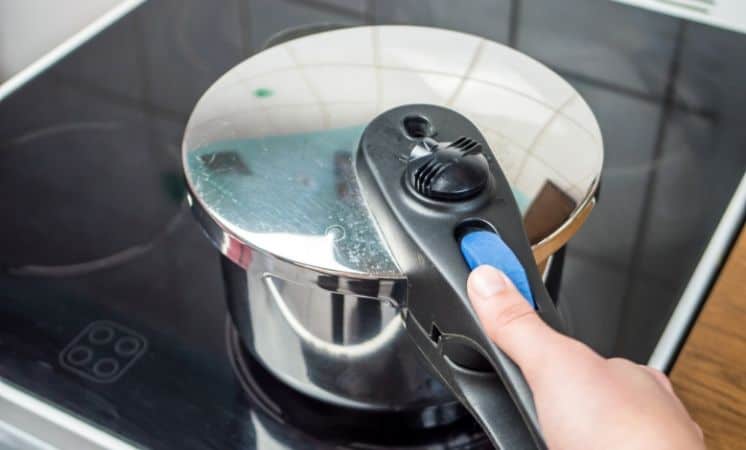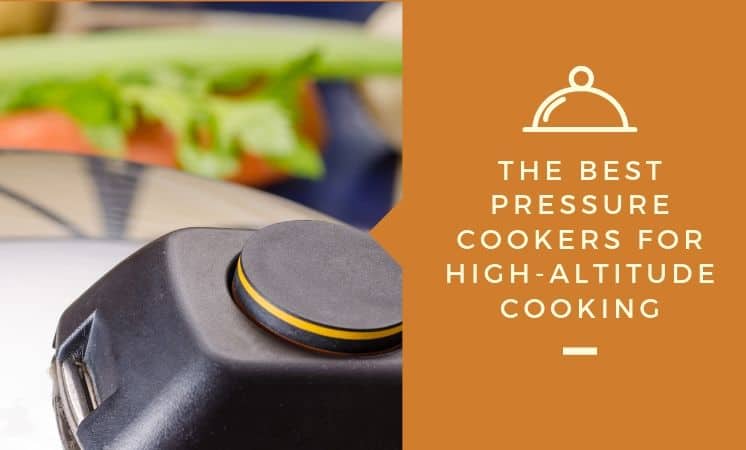While the mountains and hills are a picturesque sight to behold, for those who live at high-altitudes or for those who like to frequently backpack on trails at high elevations, may find that the geographical area can be quite a nuisance when it comes time to cook a good meal.
With the panoramic pictures comes a very dry, thin air that sits at a low atmospheric pressure, which makes cooking take longer than traditional sea level cooking. In this article, we are going to provide you with some tips on cooking at high-altitudes with pressure cookers, how cooking time is impacted by the high-altitude, and which three pressure cookers are the best for high-altitude cooking.
The Best Electric Pressure Cookers for High-Altitude Cooking
The third generation pressure cookers are electric and come with a bunch of different functions and safety features that traditional stovetop pressure cookers don’t have. They are often programmed to start a cooking cycle at the push of a button, and they come with programs suitable for different types of cooking.
The Instant Pot Ultra

The Instant Pot Ultra is a 6-quart, 10-in1 multi-use programmable pressure cooker from Instant Pot. For those who love using the Instant Pot brand name but live at high-altitudes, this model is a must-have as it comes with altitude adjustment, a cooking indicator, and a steam release reset button.
With its ultimate custom programming, you have precise cooking options with the temperature and altitude unit, sound, warm, delay, temperature, and pressure. The altitude adjustment feature takes the guesswork out of converting your recipes from sea level to high-altitude, giving you precise cooking time without the manual math.
The cooking indicator will allow you to monitor exactly what is happening with your food; whether you are still in the pre-heating stage, cooking stage, or are just keeping your food warm. It weighs in at 11 pounds.

Breville Fast Slow Pro
The Breville Fast Slow Pro is one of the highest performing counter-top models on the market, coming in feature-packed with a 6.5-quart capacity. It provides you with manual control over the pressure being used and the timing, all in one very easy-to-use interface.
Just simply turn the knobs to the pre-set you want or adjust them manually through the intervals provided. This pressure cooker can cook at 0.5 PSI to 12 PSI and comes with dual sensors, one in the base and one in the lid.
This means that you are going to get an accurate picture of what is going on inside while you cook, allowing you to adjust the heat, reduce the internal pressure, or vent steam as you see fit.
Beyond the fact that it comes with dual sensors, the Breville Fast Slow Pro also comes with an automatic adjustment and automatic pressure release for cooking at high altitudes.
The Breville will automatically release steam at the rate you want it to (via the pre-sets) or you can choose to have it not vent at all for a natural release cool-down. It weighs in at 13 pounds.

The Best Stovetop Pressure Cookers For High-Altitude Cooking

I’ve said it before and I’ll say it again: Electric pressure cookers are so convenient, mainly because an electric pressure cooker can regulate levels and sense unsafe conditions automatically.
However, in the case of high-altitude cooking, it is beneficial for a pressure cooker to be able to operate at high PSI.
Generally, stovetop pressure cookers are able to reach 15 PSI during their peak while electric pressure cookers often operate at 12-13 PSI. They are both valid options but the stovetop cooker will be a little bit faster than its electric counterpart.
With that said, let me introduce the best option for those who live at high-altitudes and prefer the traditional stovetop pressure cooker.
Presto 23 Quart Pressure Canner & Cooker
While the Presto 23-Quart is both a canner and a pressure cooker, it is recommended for use at high altitudes because it comes with a deluxe pressure dial gauge.
This dial has a complete range of processing pressures and provides the user with precise number measurement, which is especially important for monitoring internal temperatures when at high-elevation.
The product is recommended safe by the US Department of Agriculture for canning purposes, it can double as a boiling-water canner, comes with a warp-resistant aluminum gauge, and has an extended 12-year limited warranty on it. It comes with a 76-page instruction and recipe booklet and only weighs 12 pounds.

What You Need to Know When Pressure Cooking at High-Altitudes.
- Increasing the temperature when boiling foods at high-altitudes is going to do nothing for you, except make your food that much drier when it’s done. Unlike cooking at sea level, increasing the temperature is not going to help your food cook faster but simply boil the water away more quickly. Why? The temperature of the boiling liquid cannot exceed its own boiling point unless you are using a pressure cooker. This means that you have to increase your cook time, not your cook heat.
- If you want to keep your foods moist while cooking at high-altitudes, always cover your food tightly.
- Always use a food thermometer. When cooking at high altitudes, it is very easy to undercook your food which can lead to a whole host of nasty health problems.
- A common rule of thumb with meat and poultry is that it will always take twenty-five percent more cooking time when cooking at high altitudes. The only time that this does not apply is when you are oven-roasting meat or poultry or using dry-heat cooking techniques like roasting or grilling.
- Every 500-foot increase in elevation will translate into a one-degree Fahrenheit decrease in the boiling temperature of the water. So, at 500-feet above sea level, your boiling point for water is 211 degrees Fahrenheit, not 212. This becomes drastic when you are at 5,000 or 7,000 feet and the water boils at 203- and 198-degrees Fahrenheit, respectively.
- Leavening agents, such as baking powder, soda, and yeast have more rising power because the thinner air offers less resistance. You generally want to use 20 percent less at 5,000 feet above sea level.
- Keep the lid of your pressure cooker tightly sealed at all times. Do not take a peek at your food as you risk undercooking it, evaporating all the water, and drying out your food.
- When your recipe calls for a temperature of 400- or 425-degrees Fahrenheit, decrease the temperature by 24-30 degrees Fahrenheit. When cooking vegetables, poultry, or roast beef, decrease the provided temperature by 5-10 degrees Fahrenheit. Doing this helps prevent your food from drying out quicker.
- It is always recommended to use the natural release method with your pressure cooker at high-altitudes as this will help keep your food moist for longer.
How High-Altitude Affects Your Cooking Times.
When you are cooking at high altitudes, you have to take into account that the atmospheric pressure is lower, which causes water to not only evaporate faster but also reach its boiling point faster, all at a lower temperature threshold. Here is what this looks like:
- At 3,000 feet in elevation, your water is going to reach a boiling point at 207 degrees Fahrenheit.
- At 5,000 feet in elevation, your water is going to reach a boiling point at 203 degrees Fahrenheit.
- At 7,000 feet in elevation, your water is going to reach a boiling point at 198 degrees Fahrenheit.
This means that the higher you are in elevation, the longer your food is going to take to cook when using water-cooking methods. With the above elevation examples, here is what it looks like between 30 minutes of standard cooking time and the time you would need to cook the food using a pressure cooker.
- At 3,000 feet in elevation, you would need to add an additional 1.5 minutes.
- At 5,000 feet in elevation, you would need to add an additional 4.5 minutes.
- At 7,000 feet in elevation, you would need to add an additional 7.5 minutes.
To figure out how much additional time you would need, you would take the cooking time of your recipe and multiply it by the percentage increase required of your elevation level.
The general rule of thumb is to add five percent every 1,000 feet after the 2,000-sea level minimum. As you can see, a roast is going to take a lot longer to cook at 7,000 feet than it will at 3,000 feet.
Wrapping It Up.
The main thing to keep in mind is that when using a pressure cooker at high altitudes, you are going to want to adjust your cooking time appropriately to the elevation you are at.
The best thing you can do for seamless high-elevation cooking is to (a) get a pressure cooker that has automatic pressure adjustments, (b) manual pressure and timing customization, and (c) precise internal temperature regulation. All of these features will help you cook a fantastic meal, every time.

